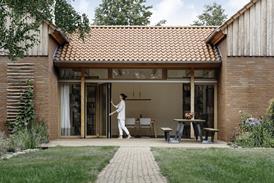MEP worked with data converted directly from a three-dimensional model of the building and its services produced by Fulcro Services. It used software developed in-house to produce fully-dimensioned manufacturing and installation drawings, plus bills of materials. This took around 20% of the time that would otherwise be required.
The Fulcro model was forwarded simultaneously to the ductwork contractor, Isotemp. This enabled it to manufacture fully co-ordinated ductwork within MEP's plant at the same time. The first 20 modules were completed with all pipework and fittings, valves, containment, insulation and supply and extract ductwork ready to be delivered to site in just two weeks from inception.
One over the eight
Phase eight of the hospital construction is scheduled to be handed over in September. It comprises a 130-bed, severe mental health unit and is part of the £335 million Private Finance Initiative (PFI) project for the new hospital.
Design and construction of the overall scheme, due for completion in 2006, is the responsibility of the Skanska Innisfree consortium, which includes the Skanska Integrated Projects (SIP) division of Skanska Construction UK and building services consultant Troup Bywaters + Anders.
Work on the mental health unit foundations commenced in July 2003. From the start it was clear that imaginative and radical decisions would be needed to ensure that the 13-month contract would be finished on time.
SIP project manager Andy Mitchell and the contractors quickly established an innovative and fast track programme. As a result of carefully co-ordinated teamwork, it also proved to be workable.
The key to the programme's success was the decision to adopt off-site prefabrication of the m&e services and install them in unison with the structural building work. The expected end result is an estimated 15% saving in m&e services installation costs and a ten-week reduction in installation time.
The mental health unit is predominantly a single-storey building, with around 50% rising to second-storey level, plus plant and ancillary rooms on the third storey. Patient areas are constructed mainly from prestressed concrete walls and plaster-board ceilings without access panels.
Each bedroom has a riser attached with all services isolated outside the room and recoverable via a central point. Chilled water and lphw are supplied via a single 250 kW capacity chiller and two 680 kW boilers, plus a 250 kW boiler dedicated to summer use.
In general, a natural ventilation philosophy has been adopted throughout, although chilled water is supplied to high-load areas and those over 6 m from openable windows. In addition, 40 secure intensive care rooms are supplied with chilled water to maintain summer temperatures at a maximum of 26°C for no more than 2·5% of any calendar year.
Tempered air is distributed via low pressure ductwork and four-way diffusers, although a vav system serves the 100-seat lecture theatre and seminar rooms at the centre of the building.
3D vision
Operations began with the production by co-ordinated m&e services designer, Fulcro Services, of the three-dimensional model of the building. This was created using architectural and structural cad data and the consultant's services drawings.
Construction of the mental health unit is based primarily on precast, prestressed concrete sections, finished off site and delivered complete with predetermined services distribution holes in place.
Fulcro's model included almost 1000 such sections, each referenced from live manufacturing data. Several factors needed close consideration as the services were being detailed, such as a 25 mm difference in screed depth to compensate for the pre-loading of the structure, plus the 75 mm fire cladding around the beams. Nevertheless, within five weeks all 24 electrical cupboards had been detailed, complete with incoming services and dimensioned distribution panels.
Shortly after this, prefabrication contractor MEP Solutions commenced the conversion of Fulcro's model into its own detailed and dimensioned production drawings. At this point the contract was ten weeks into its production schedule.
The first MEP Solutions modules arrived on site on 27 November 2003, complete with pre-insulated, pre-tested heating and dhcw services pipes, electrical containment, trays, trunking and racking, plus the ductwork for connection to the project's pressurised air supply and extract system.
The critical path adopted for the ductwork programme is further evidence of close teamwork. For example, the reasoning that it would be easier and quicker for Isotemp to install ductwork onto the services modules at workbench level within MEP's factory, rather than at ceiling level on site, also contributed to savings in installation time and costs.
Throughout the manufacturing stage, Isotemp operatives and a supervisor installed ductwork at the same time as MEP's workforce installed the pipework and containment. Further time was also saved since ductwork could be sealed and delivered to site within the racks in pristine condition and without the need for subsequent cleaning.
Each co-ordinated services module measures around 6 m long, 2 m wide and 600 mm deep, and weighs in the region of 300 kg. Carbon steel and stainless steel Mapress tube and pressfittings, insulated with phenolic foam are used for the heating and chilled water mains. Mapress copper tube and pressfittings are used on the dhcw circuits. The services were identified and colour-coded by MEP Solutions during prefabrication. The programme called for all modules to be complete and on site by the end of April.
Touching the void
Outlining the strategic thinking behind the approach, Mitchell comments: "As soon as the ceiling void depth of 800 mm plus modularised services had been established, work commenced on the 3D model of the primary distribution circuits.
"My engineering team was initially somewhat sceptical about this approach, which had probably not previously been applied in such a fully co-ordinated manner." A mock-up of the first corridor section of modularised racking was built. Once it was installed on site all the earlier scepticism evaporated.
"Nevertheless, when the first project modules proper arrived it became clear that our calculations concerning their integration into the building structure were a little out," explains Mitchell. "The reason was straightforward enough. The m&e design from Fulcro and MEP's manufacturing process produced modules to much tighter tolerances than those of the building structure used for the 3D model."
This caused a few initial problems, such as aligning the drainage pop-ups, which were soon rectified by the contractors matching the module tolerances. These and other minor glitches were quickly overcome by changing the 'rules of engagement' concerning the co-ordination of drawings and builders' work.
"The beauty of the route we took is that it ruled out any delays caused by trade contractors having to wait for each other to complete their work programme," stresses Mitchell. "In my opinion, an example of teamwork at its very best. In effect, it meant that once primary distribution circuits and containment were in place, secondary distribution could be instigated almost immediately.
"Our impression of the Mapress system is also positive, particularly since this is the first phase of the project on which it has been adopted to date. Although a little more expensive up front, the cost-effective attitude adopted by our cad engineer, Fulcro, regarding the use of fittings more than compensated.
"The system lends itself to modularised services and keeps labour costs at a minimum since the modules are built off site. Furthermore, the system was air-tested at MEP Solutions' works and since the fittings and jointing system are rated at 16 bar, we're confident of its ability to function safely at the required working pressure."
Commissioning will take place in three stages between April and August. The construction team is working towards completion in mid-August, ahead of the September scheduled date.
Source
Electrical and Mechanical Contractor

















No comments yet